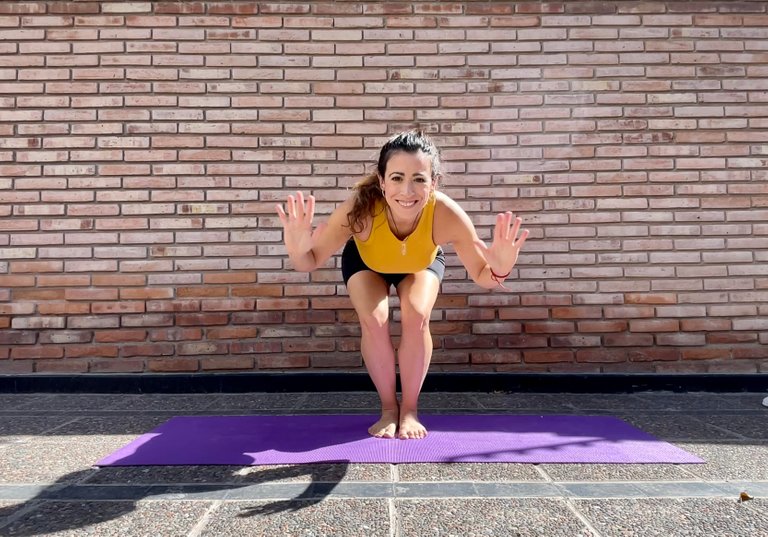English
STANDING BALANCE IN YOUR YOGA PRACTICE AND IN ANY OTHER KIND OF WORKOUT
Hello my dear friends of the Full Deportes community, as always, it's a pleasure to be here with you!!!
In this little practice I bring you 4 postures specifically for balance so you can add to your workouts.
As I have already shown in other videos, sometimes it is good to mix disciplines and take from certain practices, exercises or postures that expand and strengthen the physical exercise.
Español
BALANCE DE PIE EN TU PRÁCTICA DE YOGA Y EN CUALQUIER OTRO TIPO DE ENTRENAMIENTO
Hola mis queridos amigos de la comunidad de Full Deportes, como siempre, es un placer estar aquí con ustedes!!
En esta pequeña práctica les traigo 4 posturas específicamente de equilibrio para que puedan agregar a sus entrenamientos.
Como ya he mostrado en otros videos, a veces está bueno mezclar disciplinas y tomar de ciertas prácticas, ejercicios o posturas que expandan y fortalezcan el ejercicio físico.



Benefits
Just as I often add traditional abdominal crunches to my Yoga practices to strengthen the area so I can hold intermediate-advanced level postures, I recommend that you implement some Yoga postures in your workouts. If you are wondering why, here are some of the benefits you will get:
You will increase muscle elasticity, allowing the muscle to expand and contract more easily when doing a muscle workout.
You will be able to prevent injuries more easily because the muscles and various tissues will yield more to the different movements.
You will activate small muscles that are virtually untouched by the training of large muscle groups, in fact, this is something you will notice after the first practice.
You will increase your concentration when training.
You will increase your body awareness.
In the specific case of these standing and balancing postures, what is achieved is to strengthen the legs, of course, and also, after practice, you will reach full concentration to hold these postures, which subsequently translates into an improvement of posture in general, both in training and in everyday life.
Beneficios
Así como yo muchas veces agrego a mis prácticas de Yoga abdominales tradicionales para fortalecer la zona y así poder sostener posturas de nivel intermedio-avanzado, les recomiendo que en sus entrenamientos implementen algunas posturas de Yoga. Si se están preguntando por qué, aquí les dejo algunos de los beneficios que obtendrán:
Aumentarás la elasticidad del músculo, permitiendo que el mismo se expanda y contraiga con mayor facilidad al momento de hacer un entrenamiento de musculatura.
Podrás prevenir lesiones con mayor facilidad porque justamente los músculos y diversos tejidos cederán más a los diferentes movimientos.
Activarás pequeños músculos que no se tocan prácticamente con el entrenamiento de los grandes grupos musculares, de hecho, esto es algo que notarás tras la primera práctica
Incrementarás tu concentración al momento de entrenar
Aumentarás tu conciencia corporal
En el caso concreto de estas posturas de pie y de balance, lo que se logra es fortalecer las piernas, por su puesto, y también, tras la práctica, se alcanza plena concentración para sostener estas posturas, lo que se traduce posteriormente en una mejora de la postura a nivel general, tanto en el entrenamiento, como en la vida cotidiana.



How to do it
Let's remember that how we place our feet is how this then impacts our knees and hips. In the balancing postures a very marked focus is reached on the sole of the foot. When trying to hold these asanas, it is essential to activate the heel and big toe to mark the arch, or create it in case there is flat feet. This practice even generates enormous improvements in pathologies such as the one mentioned above.
The hip should be placed slightly forward, to create a straight line that extends towards the crown of the head, which will be placed parallel to the sky.
The shoulders are placed away from the ears and the hands can be placed on the waist, in anjali mudra or the arms can be extended upwards or to the sides, depending on the posture.
Técnica
Recordemos que como colocamos los pies es como después esto repercute en nuestras rodillas y caderas. En las posturas de equilibrio se alcanza un foco muy marcado en la planta del pie. En el momento de intentar sostener estas asanas, es imprescindible activar el talón y el dedo gordo del pie para marcar el arco, o crearlo en caso de que exista pie plano. Esta práctica incluso llega a generar enormes mejoras en patologías como la mencionada.
La cadera debe estar colocado levemente hacia adelante, para crear una línea recta que se extienda hacia la coronilla, que se ubicará paralela al cielo.
Los hombros se colocan alejados de las orejas y las manos pueden ir en la cintura, en anjali mudra o se pueden extender los brazos hacia arriba o hacia los costados, dependiendo de la postura.


Datos de edición
Dispositivo: iPhone 12 Pro
Banner: Canva
Aplicación de edición: InShot (versión de pago)
Traducción: DeepL
Música: Night out
Músico: LiQWYD
Edition data
Device: iPhone 12 Pro
Banner: Canva
App for video edition: InShot (Paid version)
Translation: DeepL
Music: Night out
Musician: LiQWYD


▶️ 3Speak
